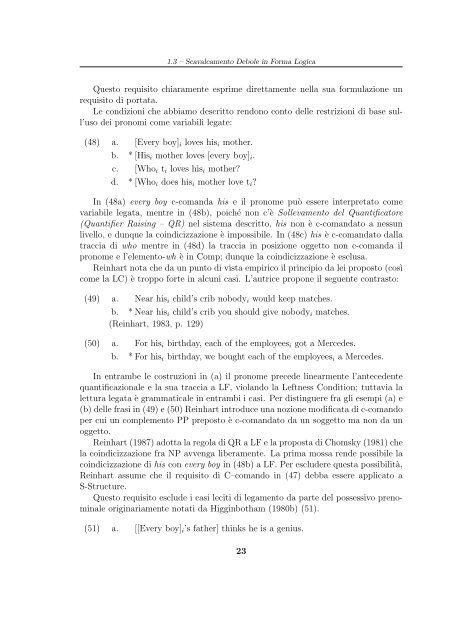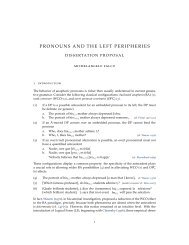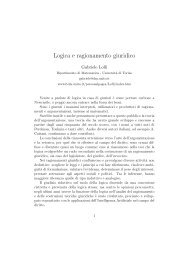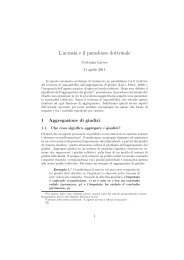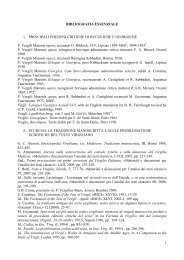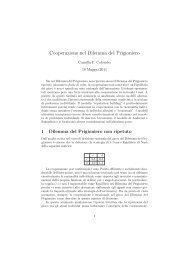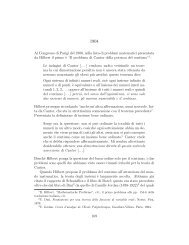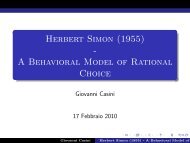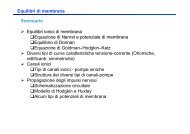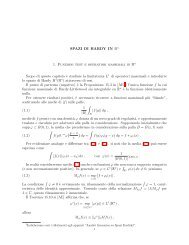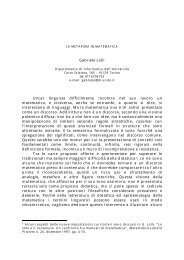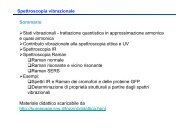Scavalcamento Debole e Catene in Forma Logica - Pagine ...
Scavalcamento Debole e Catene in Forma Logica - Pagine ...
Scavalcamento Debole e Catene in Forma Logica - Pagine ...
Create successful ePaper yourself
Turn your PDF publications into a flip-book with our unique Google optimized e-Paper software.
1.3 – <strong>Scavalcamento</strong> <strong>Debole</strong> <strong>in</strong> <strong>Forma</strong> <strong>Logica</strong><br />
Questo requisito chiaramente esprime direttamente nella sua formulazione un<br />
requisito di portata.<br />
Le condizioni che abbiamo descritto rendono conto delle restrizioni di base sull’uso<br />
dei pronomi come variabili legate:<br />
(48) a. [Every boy]i loves hisi mother.<br />
b. * [Hisi mother loves [every boy]i.<br />
c. [Whoi ti loves hisi mother?<br />
d. * [Whoi does hisi mother love ti?<br />
In (48a) every boy c-comanda his e il pronome può essere <strong>in</strong>terpretato come<br />
variabile legata, mentre <strong>in</strong> (48b), poiché non c’è Sollevamento del Quantificatore<br />
(Quantifier Rais<strong>in</strong>g – QR) nel sistema descritto, his non è c-comandato a nessun<br />
livello, e dunque la co<strong>in</strong>dicizzazione è impossibile. In (48c) his è c-comandato dalla<br />
traccia di who mentre <strong>in</strong> (48d) la traccia <strong>in</strong> posizione oggetto non c-comanda il<br />
pronome e l’elemento-wh è <strong>in</strong> Comp; dunque la co<strong>in</strong>dicizzazione è esclusa.<br />
Re<strong>in</strong>hart nota che da un punto di vista empirico il pr<strong>in</strong>cipio da lei proposto (così<br />
come la LC) è troppo forte <strong>in</strong> alcuni casi. L’autrice propone il seguente contrasto:<br />
(49) a. Near hisi child’s crib nobodyi would keep matches.<br />
b. * Near hisi child’s crib you should give nobodyi matches.<br />
(Re<strong>in</strong>hart, 1983, p. 129)<br />
(50) a. For hisi birthday, each of the employeesi got a Mercedes.<br />
b. * For hisi birthday, we bought each of the employeesi a Mercedes.<br />
In entrambe le costruzioni <strong>in</strong> (a) il pronome precede l<strong>in</strong>earmente l’antecedente<br />
quantificazionale e la sua traccia a LF, violando la Leftness Condition; tuttavia la<br />
lettura legata è grammaticale <strong>in</strong> entrambi i casi. Per dist<strong>in</strong>guere fra gli esempi (a) e<br />
(b) delle frasi <strong>in</strong> (49) e (50) Re<strong>in</strong>hart <strong>in</strong>troduce una nozione modificata di c-comando<br />
per cui un complemento PP preposto è c-comandato da un soggetto ma non da un<br />
oggetto.<br />
Re<strong>in</strong>hart (1987) adotta la regola di QR a LF e la proposta di Chomsky (1981) che<br />
la co<strong>in</strong>dicizzazione fra NP avvenga liberamente. La prima mossa rende possibile la<br />
co<strong>in</strong>dicizzazione di his con every boy <strong>in</strong> (48b) a LF. Per escludere questa possibilità,<br />
Re<strong>in</strong>hart assume che il requisito di C–comando <strong>in</strong> (47) debba essere applicato a<br />
S-Structure.<br />
Questo requisito esclude i casi leciti di legamento da parte del possessivo prenom<strong>in</strong>ale<br />
orig<strong>in</strong>ariamente notati da Higg<strong>in</strong>botham (1980b) (51).<br />
(51) a. [[Every boy]i’s father] th<strong>in</strong>ks he is a genius.<br />
23


